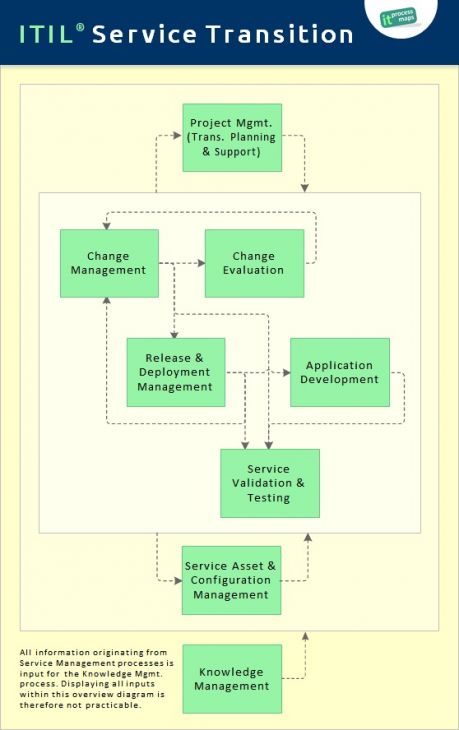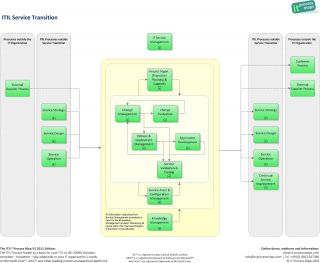Which Of The Following Is Not A Process Of Itil Service Transition?
ITIL Service Transition
From IT Process Wiki
![]()
Objective: The objective of ITIL Service Transition is to build and deploy It services. The Service Transition lifecycle stage as well makes certain that changes to services and service direction processes are carried out in a coordinated way.
Part of: Information technology Service Management | ITIL processes
Processes: ITIL Service Transition
Service Transition builds and deploys new or modified services.

The ITIL service lifecycle stage of Service Transition (see fig. i) includes the following main processes :
- Change Management
- Process Objective: To control the lifecycle of all Changes. The primary objective of Change Management is to enable beneficial Changes to be fabricated, with minimum disruption to Information technology services.
- Change Evaluation
- Process Objective: To assess major Changes, similar the introduction of a new service or a substantial alter to an existing service, before those Changes are immune to proceed to the next phase in their lifecycle.
- Application Development
- Procedure Objective: To brand bachelor applications and systems which provide the required functionality for IT services. This process includes the development and maintenance of custom applications as well as the customization of products from software vendors.
- Release and Deployment Management
- Process Objective: To plan, schedule and control the movement of releases to examination and live environments. The principal goal of Release Management is to ensure that the integrity of the live environment is protected and that the right components are released.
- Service Validation and Testing
- Procedure Objective: To ensure that deployed Releases and the resulting services meet client expectations, and to verify that Information technology operations is able to back up the new service.
- Knowledge Management
- Process Objective: To gather, clarify, store and share knowledge and information inside an arrangement. The main purpose of Knowledge Management is to ameliorate efficiency by reducing the need to rediscover knowledge.
ITIL four Service Transition
The Service Transition processes described here (fig. ane) follow the specifications of ITIL V3, where Service Transition is the third phase in the Service Lifecycle.
ITIL V4 has moved from the Service Lifecycle concept to a more holistic approach that includes central concepts, the Iv Dimensions Model and the Service Value Organisation (SVS).
Instead of processes, ITIL iv describes 34 'practices', and many of the 26 processes specified in ITIL V3 can be found in ITIL 4 as practices. For case, ITIL V4 refers to Change Management and Configuration Management equally practices (Change Management has been renamed to "Change Enablement").
The shift from processes to practices ways ITIL V4 is no longer prescriptive nigh processes and gives organizations more freedom to ascertain tailor-made Service Transition processes.
Since the processes specified in ITIL V3 have not been invalidated with the introduction of ITIL V4, organizations that need to define their Service Transition processes can still utilise the processes specified in ITIL V3 equally templates.
KPIs | Templates | Roles
- KPIs for Service Transition
- Service Transition templates and checklists
- ITIL roles within Service Transition
Downloads

The ITIL discipline Service Transition at a glance
Use the following links to open the process overview of Service Transition showing the most important interfaces:
- Service Transition (.JPG)
- Service Transition (.PDF)
Notes
By: Stefan Kempter![]() , Information technology Process Maps.
, Information technology Process Maps.
ITIL iv Service Transition › Alter Management › [...] › Release Mgmt. › Service Validation › Configuration Mgmt. › Cognition Mgmt.
Which Of The Following Is Not A Process Of Itil Service Transition?,
Source: https://wiki.en.it-processmaps.com/index.php/ITIL_Service_Transition
Posted by: chenaultanneized.blogspot.com


0 Response to "Which Of The Following Is Not A Process Of Itil Service Transition?"
Post a Comment